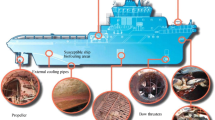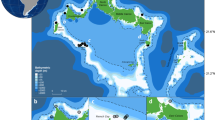Abstract
A system for real-time monitoring the depth of small fishing gear was developed using acoustic telemetry to improve the efficiency of fishing operations. The system consisted of an acoustic transmitter (pinger), an omni-directional hydrophone with a depressor, and a receiver. Using a pinger equipped with a depth sensor, a fisherman can confirm whether the fishing gear is at the intended depth. The battery of the developed pinger can be replaced easily for repeated use. The performance of the system was evaluated in a field experiment. The accuracy of measured depth was 0.4 m and was constant even if the pinger was moving. In the experiment, the system could successfully monitor the pinger depth every several second. The system was implemented in hairtail trolling to examine its effectiveness. The implementation experiments revealed some issues with the system, such as the effect of signal reflections or the installation method of the hydrophone. However, the system could monitor the depth of the fishing gear continuously in real time and it operated successfully without any problem during the fishing operation. Application of the developed system is expected to aid fishermen in adjusting the gear depth easily and accurately.












Similar content being viewed by others
References
Misund OA (1997) Underwater acoustics in marine fisheries and fisheries research. Rev Fish Biol Fisher 7:1–34
Valdemarsen JW (2001) Technological trends in capture fisheries. Ocean Coast Manage 44:635–651
Engås A, Godø OR (1986) Influence of trawl geometry and vertical distribution of fish on sampling with bottom trawl. J Northw Atl Fish Sci 7:35–42
Engås A, Ona E (1990) Day and night fish distribution pattern in the net mouth area of the Norwegian bottom-sampling trawl. Rapp P-v Réun Cons int Explor Mer 189:123–127
Graham N, Jones EG, Reid DG (2004) Review of technological advances for the study of fish behaviour in relation to demersal fishing trawls. ICES J Mar Sci 61:1036–1043
Haugland EK (2011) Pelagic fish behaviour during trawl sampling off Angola. Open Oceanogr J 5:22–29
Rosen S, Engås A, Fernö A, Jörgensen T (2012) The reactions of shoaling adult cod to a pelagic trawl: implications for commercial trawling. ICES J Mar Sci 69(2):303–312
Misund OA (1990) Sonar observations of schooling herring: school dimensions, swimming behaviour, and avoidance of vessel and purse seine. Rapp P-v Réun Cons Int Explor Mer 189:135–146
Abad R, Miquel M, Iglesias M, Alvarez F (1998) Acoustic estimation of abundance and distribution of anchovy in the NW Mediterranean. Sci Mar 62(1–2):37–43
Ohshimo S (2004) Spatial distribution and biomass of pelagic fish in the East China Sea in summer, based on acoustic surveys from 1997 to 2001. Fish Sci 70:389–400
Kaartvedt S, Staby A, Aksnes DL (2012) Efficient trawl avoidance by mesopelagic fishes causes large underestimation of their biomass. Mar Ecol Prog Ser 456:1–6
Voegeli FA, Smale MJ, Webber DM, Andrade Y, O’Dor RK (2001) Ultrasonic telemetry, tracking and automated monitoring technology for sharks. Environ Biol Fish 60:267–281
Espinoza M, Farrugia TJ, Webber DM, Smith F, Lowe CG (2011) Testing a new acoustic telemetry technique to quantify long-term, fine-scale movements of aquatic animals. Fish Res 108:364–371
Brown RS, Cooke SJ, Anderson WG, McKinley RS (1999) Evidence to challenge the “2% rule” for biotelemetry. N Am J Fish Manage 19:867–871
Voegeli FA, Lacroix GL, Anderson JM (1998) Development of miniature pingers for tracking Atlantic salmon smolts at sea. Hydrobiologia 371(372):35–46
McMichael GA, Eppard MB, Carlson TJ, Carter JA, Ebberts BD, Brown RS, Weiland M, Ploskey GR, Harnish RA, Deng ZD (2010) The juvenile salmon acoustic telemetry system: a new tool. Fisheries 35(1):9–22
Miyamoto Y, Uchida K, Takao Y, Sasakura T (2011) Development of a new ultrasonic biotelemetry system using a maximum length sequence signal. J Marine Acoust Soc Jpn 38(3):119–127 (in Japanese with English abstract)
Sasakura T, Miyamoto N, Miyamoto Y, Matsumoto Y, Ito K (2013) Correlation ASIC applied to underwater acoustics. In: Proceedings of 1st international conference and exhibition on underwater acoustics, pp 1445–1450
Okabe T, Aoki S, Kawamura M (2008) Study on frequent monitoring of wide area bathymetry using fish finder data of whitebait fishing boats. Proc Coast Eng, JSCE 55:661–665 (in Japanese with English abstract)
Wenz GM (1962) Acoustic ambient noise in the ocean: spectra and sources. J Acoust Soc Am 24(12):1936–1956
Hildebrand JA (2009) Anthropogenic and natural sources of ambient noise in the ocean. Mar Ecol Prog Ser 395:5–20
Fuwa S, Ishizaki M, Ebata K, Fujita S (2002) Fluid dynamic resistance for the trolling depressor. Fish Sci 68:751–756
Acknowledgments
This study was supported by JSPS KAKENHI Grant Number 2510728. We would like to thank Dr. Toyoki Sasakura and Mr. Yuzo Abe of FUSION Inc. for their technical support. We would also like to thank Mr. Akira Adachi, President of KODEN Inc., for arranging the experiments, and Captain Kazuo Hatozaki for his support during the field experiments.
Author information
Authors and Affiliations
Corresponding author
Rights and permissions
About this article
Cite this article
Hasegawa, K., Miyamoto, Y. & Uchida, K. Development of a real-time depth monitoring system for small fishing gear using an acoustic telemetry technique. Fish Sci 82, 213–223 (2016). https://doi.org/10.1007/s12562-015-0963-7
Received:
Accepted:
Published:
Issue Date:
DOI: https://doi.org/10.1007/s12562-015-0963-7




